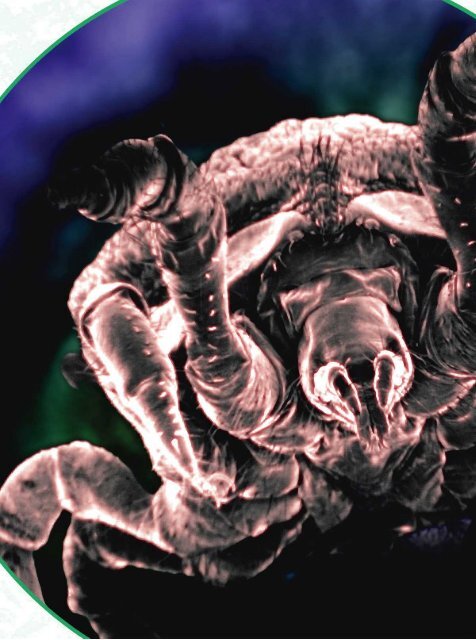Selected US Ticks and Tick-borne Pathogens - tabpi
Selected US Ticks and Tick-borne Pathogens - tabpi
Selected US Ticks and Tick-borne Pathogens - tabpi
You also want an ePaper? Increase the reach of your titles
YUMPU automatically turns print PDFs into web optimized ePapers that Google loves.
The epidemiology of tick-<strong>borne</strong> disease is<br />
changing: ticks are moving into new areas <strong>and</strong><br />
are being linked to new diseases. VETERINARY<br />
FORUM talks with leading experts to update you<br />
on the problem.<br />
The tick population in the United States is exploding. Driven by socioeconomic<br />
factors, changing climate <strong>and</strong> an increase in the number <strong>and</strong><br />
distribution of wildlife hosts, ticks have successfully spread across the<br />
country, changing the l<strong>and</strong>scape of zoonotic diseases.<br />
Two ticks are particularly troublesome in the United States: Amblyomma americanum<br />
(the Lone Star tick) <strong>and</strong> Ixodes scapularis (the black-legged or deer tick).<br />
They have spread across nearly half of the country, overlapping in many states,<br />
<strong>and</strong> have been implicated in transmitting nearly a dozen infectious disease<br />
pathogens to both humans <strong>and</strong> animals.<br />
“Based on clinical evidence <strong>and</strong> the literature, there appears that at least two major<br />
tick species have exp<strong>and</strong>ed their ranges <strong>and</strong> even their density within those<br />
ranges over the past 15 to 20 years,” explains Michael W. Dryden, DVM, PhD, who is<br />
professor of veterinary parasitology at the Kansas State University College of Veterinary<br />
Medicine. “Those tick species are Ixodes scapularis in the eastern half of the United States,<br />
which is our major Lyme disease <strong>and</strong> human anaplasmosis vector, <strong>and</strong> Amblyomma americanum,<br />
which is a big ehrlichiosis vector.”<br />
B y M a r i e R o s e n t h a l , M S • E x e c u t i v e E d i t o r<br />
May 2007 | Veterinary Forum 45
Massive<br />
increase in the<br />
deer population<br />
over the past<br />
100 years<br />
Suburbanization<br />
bringing people,<br />
wildlife <strong>and</strong> ticks<br />
together<br />
I. scapularis has been reported from<br />
Minnesota to Miami <strong>and</strong> from Bangor,<br />
Maine, to Corpus Christi, Texas, <strong>and</strong> A.<br />
americanum has been found from Corpus<br />
Christi to southern Michigan <strong>and</strong> from<br />
southern Florida to Maine, according to<br />
Dryden.<br />
Katherine M. Kocan, PhD, agrees,<br />
adding that the rise in the role of A.<br />
americanum has been one of the most<br />
fascinating aspects of her field of study.<br />
“Historically, the Lone Star tick, or A.<br />
americanum, was considered insignificant<br />
as a vector of disease, but now it is considered<br />
the number one vector. It used<br />
to be if someone got a Lone Star tick on<br />
them, I’d say don’t worry, you don’t<br />
have any risk of disease,” says Kocan,<br />
who is regents professor <strong>and</strong> Walter R.<br />
Sitlington endowed chair of food animal<br />
research in the department of pathobiology<br />
at the Center for Veterinary<br />
Health Sciences at Oklahoma State University.<br />
”But in the past 15 years or so,<br />
the Lone Star tick has become our number<br />
one tick vector in the United States.<br />
I think it is one of the most interesting<br />
<strong>and</strong> dramatic things going on in the<br />
study of tick-<strong>borne</strong> diseases in the<br />
United States.”<br />
© Wolfgang Rücki, Svetlana Larina, Michael West, Mark/Shutterstock<br />
Source: CDC<br />
Dispersal of<br />
juvenile ticks by<br />
migratory birds<br />
VETERNARY FORUM<br />
Increase in<br />
outdoor<br />
recreational<br />
activities<br />
And then there were?<br />
<strong><strong>Tick</strong>s</strong> are the most common transmitters<br />
of vector-<strong>borne</strong> diseases in the<br />
United States. They wait in vegetation for<br />
a host <strong>and</strong> then attach themselves using<br />
a hypostome to pierce the skin. During a<br />
blood meal, they transmit a variety of<br />
pathogens, including bacteria, spirochetes<br />
<strong>and</strong> rickettsiae.<br />
Most of the pathogens linked to A.<br />
americanum cause emerging diseases,<br />
Kocan explains, <strong>and</strong> the number associated<br />
with the tick has risen from zero to<br />
seven: Ehrlichia chaffeensis, which causes<br />
human monocytic ehrlichiosis; E. ewingii,<br />
which causes canine <strong>and</strong> human granulocytic<br />
ehrlichiosis; Francisella tularensis,<br />
the cause of tularemia; Rickettsia amblyommii,<br />
the cause of a rickettsial spotted<br />
fever that has not yet been named; non-<br />
46 Veterinary Forum | May 2007
pathogenic Theileria cervi in deer; <strong>and</strong> Borrelia<br />
lonestari, which has been associated<br />
with southern tick–associated rash illness<br />
(STARI), a newly described disease in humans.<br />
Another newly described disease<br />
that is associated with the Lone Star tick<br />
but does not yet have a name has been<br />
found in a goat in the United<br />
States <strong>and</strong> is caused by<br />
Ehrlichia ruminantium, which<br />
appears to be closely related<br />
to the pathogen<br />
that causes the African<br />
cattle disease known<br />
as heartwater.<br />
There are two other major tick vectors<br />
in the United States that are especially<br />
important for animal diseases: the brown<br />
dog tick <strong>and</strong> the American dog tick. Rhipicephalus<br />
sanguineus (the brown dog tick)<br />
transmits pathogens that cause the following<br />
canine diseases: Anaplasma platus,<br />
which causes a milder form of<br />
ehrlichiosis; Babesia canis,<br />
which causes babesiosis;<br />
<strong>and</strong> Ehrlichia canis, which<br />
causes canine monocytic<br />
ehrlichiosis. Outside<br />
the United<br />
States, the tick has<br />
Just because you did not diagnose this disease<br />
in your practice yesterday doesn’t mean you<br />
won’t diagnose it tomorrow.<br />
— Michael W. Dryden<br />
“In Africa, Ehrlichia ruminantium causes<br />
the cattle disease heartwater. It was reported<br />
in the Caribbean isl<strong>and</strong>s <strong>and</strong><br />
Puerto Rico some years ago, <strong>and</strong> there<br />
is a big push to eradicate the tick from<br />
the Caribbean <strong>and</strong> Puerto Rico to reduce<br />
the risk of introducing heartwater<br />
into the United States. Heartwater is a<br />
major disease in cattle in Africa,” Kocan<br />
explains. “Just recently, a closely related<br />
Erhlichia organism was described<br />
in a goat in the Northeast.”<br />
I. scapularis transmits Anaplasma phagocytophilum,<br />
which causes human granulocytic<br />
anaplasmosis; Babesia microti, the<br />
cause of rodent babesiosis as well as human<br />
infection; B. odocoilei, which appears<br />
to be host-specific for deer (cervid<br />
babesiosis) <strong>and</strong> Borrelia burgdorferi, the<br />
cause of Lyme disease. These diseases<br />
occur in a variety of animals <strong>and</strong> humans<br />
(see charts on pages 50 <strong>and</strong> 52).<br />
been implicated in the transmission of<br />
Hepatozoon canis, which causes canine hepatozoonosis,<br />
<strong>and</strong> B. gibsoni, which causes<br />
babesiosis. The brown dog tick has also<br />
been implicated in the spread of Rickettsia<br />
rickettsii, the cause of Rocky Mountain<br />
spotted fever (RMSF) in both humans<br />
<strong>and</strong> dogs.<br />
Another vector of RMSF is D. variabilis<br />
or the American dog tick, which also<br />
transmits Anaplasma marginale, the cause<br />
of anaplasmosis in cattle; Cytauxzoon felis,<br />
the cause of cytauxzoonosis in domestic<br />
<strong>and</strong> wild cats; Ehrlichia canis, the cause of<br />
canine ehrlichiosis; <strong>and</strong> E. chaffeensis,<br />
which causes ehrlichiosis in humans <strong>and</strong><br />
dogs.<br />
Although it may seem as if ticks are<br />
being infected with more organisms,<br />
which is why they are transmitting more<br />
diseases, both Dryden <strong>and</strong> Kocan say<br />
that probably isn’t the case. Instead, re-<br />
48 Veterinary Forum | May 2007
searchers <strong>and</strong> epidemiologists have the technical means to<br />
find pathogens they couldn’t find before. “<strong><strong>Tick</strong>s</strong> are not changing<br />
their ability to transmit disease,” explains Dryden, “but we<br />
are recognizing more diseases because we are looking for<br />
them.”<br />
Adds Kocan: “Molecular technologies are fabulous. We<br />
can do things that we could never do before. For instance,<br />
you can collect ticks <strong>and</strong>, using polymerase chain reaction<br />
[PCR], you can test for half a dozen parasites at one time. So<br />
ticks may have carried these pathogens all along, but we<br />
just haven’t recognized them.”<br />
Because of tick spread, increased tick density <strong>and</strong> recognition<br />
of more diseases from tick vectors, veterinarians<br />
might find it useful to include vector-<strong>borne</strong> diseases that are<br />
not common in their area as part of the diagnostic differentials<br />
if the animal’s clinical signs <strong>and</strong> presentation match the<br />
disease definition. Dryden adds: “What I tell practitioners<br />
when I get in front of an audience is very simple: ‘Whatever<br />
you knew about ticks 5 years ago, it is different today <strong>and</strong><br />
whatever you know about ticks today will be different 5<br />
years from now.’<br />
“And that is because these ticks continue to move <strong>and</strong><br />
exp<strong>and</strong> <strong>and</strong> increase in importance. Just because you did<br />
not diagnose this disease in your practice yesterday doesn’t<br />
mean you won’t diagnose it tomorrow. The situation is not<br />
static. This is a dramatic, dynamic situation we have today in<br />
the eastern half of the United States.”<br />
Hard ticks begin their life cycle as larvae, which hatch<br />
from eggs <strong>and</strong> immediately begin seeking hosts, often rodents.<br />
After the larvae successfully feed, they fall off the<br />
host <strong>and</strong> live in the soil <strong>and</strong> decaying vegetation where they<br />
then molt into nymphs, which seek their blood meal from a<br />
small vertebrate. If a nymph fails to find a blood meal, it<br />
dies. If it succeeds, it falls off the host <strong>and</strong> lives in the soil to<br />
molt into an adult. The adult seeks a larger host for its blood<br />
meal, <strong>and</strong> the preferred host for I. scapularis <strong>and</strong> A. americanum<br />
is the white-tailed deer, where the adult feeds <strong>and</strong> mates<br />
over the winter. The adult female tick is capable of laying<br />
several thous<strong>and</strong> eggs before she dies, according to Kocan.<br />
“The thing that drives the tick populations is deer. If we<br />
didn’t have deer, we wouldn’t have half the tick populations<br />
that we have,” Kocan says.<br />
When the United States was young, white-tailed deer<br />
flourished in this country, but they were over-hunted, explains<br />
Dryden. Through the 1800s, they were a major source<br />
of food in this country — even Army units supplied themselves<br />
by hunting deer. “The estimates indicate there were<br />
only between 200,000 <strong>and</strong> 300,000 white-tailed deer left in<br />
the early 1900s. Then it became illegal to hunt deer in many<br />
states,” Dryden says, as many state gaming departments<br />
tried to repopulate the species.<br />
(text continues on page 54)<br />
May 2007 | Veterinary Forum 49
<strong>Tick</strong> Species<br />
<strong>Selected</strong> <strong>US</strong> <strong><strong>Tick</strong>s</strong> <strong>and</strong> <strong>Tick</strong>-<strong>borne</strong> <strong>Pathogens</strong><br />
Pathogen(s) <strong>and</strong> Host(s)<br />
Scientific Name Common Name Scientific Name Disease/ Main Host(s)<br />
Common Name<br />
Amblyomma americanum Lone Star tick Borrelia lonestari Southern tick-associated Humans; deer<br />
rash illness (STARI)<br />
Ehrlichia chaffeensis Human monocytic Humans, deer<br />
ehrlichiosis (HME) <strong>and</strong> dogs<br />
Ehrlichia ewingii Canine granulocytic Dogs, deer <strong>and</strong><br />
ehrlichiosis in the humans<br />
United States<br />
Newly described; closely No disease name Goats<br />
related to Ehrlichia<br />
ruminantium, which causes<br />
the ruminant disease<br />
heartwater primarily<br />
in Africa.<br />
Francisella tularensis Tularemia Humans; rabbits,<br />
cats, other<br />
mammals<br />
Rickettsia amblyommii Spotted fever rickettsiae Humans <strong>and</strong><br />
group; no disease name other mammals<br />
Theileria cervi Nonpathogenic White-tailed deer<br />
Amblyomma maculatum Gulf Coast tick Ehrlichia ruminantium Experimental vector Cattle<br />
of heartwater disease<br />
in cattle<br />
Hepatozoon americanum Canine hepatozoonosis Dogs <strong>and</strong> coyotes<br />
in the United States<br />
Rickettsia parkeri No disease name Humans (?)<br />
Boophilus annulatus Cattle fever tick Anaplasma marginale Bovine anaplasmosis Cattle<br />
Babesia bigemina Bovine babesiosis or Cattle<br />
piroplasmosis<br />
Boophilus microplus Tropical cattle tick Anaplasma marginale Bovine anaplasmosis Cattle<br />
Babesia bigemina Bovine babesiosis or Cattle<br />
piroplasmosis<br />
Dermacentor albipictus Winter tick Anaplasma marginale Bovine anaplasmosis Cattle<br />
Dermacentor <strong>and</strong>ersoni Rocky Mountain Anaplasma marginale Bovine anaplasmosis Cattle<br />
wood tick<br />
Rickettsia rickettsii Rocky Mountain Humans <strong>and</strong> dogs;<br />
spotted fever (RMSF) rodent reservoir<br />
hosts<br />
(table continues on page 52)<br />
Credit: Katherine Kocan, Susan Little <strong>and</strong> Mason Reichard, Center for Veterinary Health Sciences, Oklahoma State University<br />
50 Veterinary Forum | May 2007
<strong>Selected</strong> <strong>US</strong> <strong><strong>Tick</strong>s</strong> <strong>and</strong> <strong>Tick</strong>-<strong>borne</strong> <strong>Pathogens</strong> (continued)<br />
<strong>Tick</strong> Species<br />
Pathogen(s) <strong>and</strong> Host(s)<br />
Scientific Name Common Name Scientific Name Disease/ Main Host(s)<br />
Common Name<br />
Dermacentor nitens Tropical horse tick Babesia equi Equine piroplasmosis Horses<br />
Dermacentor variabilis American dog tick Anaplasma marginale Bovine anaplasmosis Cattle<br />
Cytauxzoon felis Feline cytauxzoonosis Wild <strong>and</strong> domestic<br />
cats<br />
Ehrlichia canis Canine monocytic Dogs<br />
ehrlichiosis (CME)<br />
Ehrlichia chaffeensis Human monocytic Humans, dogs,<br />
ehrlichiosis (HME)<br />
<strong>and</strong> deer<br />
Rickettsia rickettsii Rocky Mountain Humans <strong>and</strong> dogs;<br />
spotted fever (RMSF) rodent reservoir<br />
hosts<br />
Francisella tularensis Tularemia Humans; rabbits,<br />
cats, other<br />
mammals<br />
Ixodes pacificus Western Borrelia Lyme disease Humans, dogs,<br />
Black-legged tick burgdorferi reptiles, rodents,<br />
birds<br />
Ixodes scapularis Black-legged tick Anaplasma Human granulocytic Humans <strong>and</strong><br />
phagocytophilum anaplasmosis (HGA) many reservoir<br />
hosts<br />
Babesia microti Rodent babesiosis Rodents <strong>and</strong><br />
Humans<br />
Babesia odocoilei Cervid babesiossis Deer<br />
Borrelia burgdorferi Lyme disease Humans, dogs<br />
<strong>and</strong> cattle; rodent<br />
reservoir hosts<br />
Rhipicephalus Brown dog tick Anaplasma platys* Milder form of Dogs<br />
sanguineus<br />
ehrlichiosis<br />
*Not confirmed<br />
**Not confirmed in the United States<br />
For references, please contact Marie Rosenthal at mrosenthal@vetlearn.com.<br />
Credit: Katherine Kocan, Susan Little <strong>and</strong> Mason Reichard, Center for Veterinary Health Sciences, Oklahoma State University<br />
Babesia canis Canine babesiosis Dogs<br />
Babesia gibsoni** Canine babesiosis Dogs<br />
Ehrlichia canis Canine monocytic Dogs<br />
ehrlichiosis (CME)<br />
Hepatozoon canis** Canine hepatozoonosis Dogs<br />
outside of the United States<br />
Rickettsia rickettsii Rocky Mountain Dogs <strong>and</strong> humans;<br />
spotted fever (RMSF) rodent reservoir<br />
hosts<br />
52 Veterinary Forum | May 2007
It was one of the most successful<br />
conservation efforts in history, <strong>and</strong> today,<br />
there are more than 30 million deer<br />
in this country. Humans also have eliminated<br />
the natural predators of deer, so<br />
they have flourished.<br />
“By anyone’s estimates, there are almost<br />
100 times the deer today than<br />
there was 100 years ago,” Dryden<br />
says. “I don’t care where you<br />
live, whether it is Kansas<br />
or New Jersey, when you<br />
were a kid, to see a<br />
deer was a phenomenon.<br />
Now they are<br />
everywhere, <strong>and</strong> the<br />
white-tailed deer is<br />
Other driving forces<br />
The other major driving forces behind<br />
the emergence of tick-<strong>borne</strong> diseases<br />
are the suburbanization of<br />
America; climate change; an increased<br />
incidence in outdoor recreational activities<br />
<strong>and</strong> migrating birds, according to<br />
the Centers for Disease Control <strong>and</strong><br />
Prevention (CDC).<br />
“You have changing trends in tick<br />
transmission <strong>and</strong> diseases because the<br />
environment <strong>and</strong> people are changing,”<br />
Kocan says. As people move from urban<br />
areas to suburbs <strong>and</strong> rural neighborhoods,<br />
they drive animals <strong>and</strong> their attached<br />
ticks to outlying areas moving<br />
them across the map.<br />
In addition, the trend today is not to<br />
cut forests to build tract houses but to integrate<br />
the homes with the natural surroundings.<br />
Although this is aesthetically<br />
pleasing, it brings people, wildlife <strong>and</strong><br />
ticks together. “Significant reforestation<br />
has occurred in the eastern United<br />
States over the past 100 years<br />
from massive clear cutting<br />
that occurred in the<br />
1700s <strong>and</strong> 1800s,” Dryden<br />
says. “We just are<br />
not doing that to the<br />
extent that we once<br />
did.”<br />
You have changing trends in tick transmission<br />
<strong>and</strong> diseases because the environment <strong>and</strong><br />
people are changing.<br />
— Katherine M. Kocan<br />
the primary host for adult I. scapularis<br />
<strong>and</strong> a major host for all stages of the<br />
Lone Star tick. Neither of those ticks can<br />
be maintained in high numbers in an<br />
ecosystem without white-tailed deer.”<br />
In addition, people are spending<br />
more recreational time outdoors, often<br />
with their dogs, providing another opportunity<br />
for ticks to attach. “Dogs are the<br />
ones that go out <strong>and</strong> run around <strong>and</strong><br />
bring ticks back into the human environment,”<br />
Kocan says. “I don’t think people<br />
underst<strong>and</strong> that dogs can be the big connector<br />
between people <strong>and</strong> ticks.”<br />
Migratory birds are also being recognized<br />
as both a host for various zoonotic<br />
pathogens <strong>and</strong> a carrier of ticks, which<br />
can drop off <strong>and</strong> lay eggs in new territory.<br />
According to a recent article in<br />
Emerging Infectious Diseases, North American<br />
birds host vector-<strong>borne</strong> pathogens,<br />
such as Anaplasma spp <strong>and</strong> B. burgdorferi,<br />
that infect Ixodes larvae. Although rodent<br />
species, such as the white-footed<br />
mouse, are the most common hosts of<br />
immature Ixodes ticks, alternative hosts,<br />
54 Veterinary Forum | May 2007
such as migratory birds, play a larger<br />
role than previously thought <strong>and</strong> may<br />
be hosts of epidemiologically important<br />
vector ticks.<br />
Finally, climate change is also influencing<br />
tick populations. “We are not<br />
experiencing as hard <strong>and</strong> as cold winters<br />
that we used to historically for<br />
whatever reason,” explains Dryden.<br />
“We need to protect ourselves <strong>and</strong> our<br />
dogs <strong>and</strong> cats. With the winters not being<br />
as hard as they used to be in many<br />
areas, we’ve gone to year-round tick<br />
control for our pets.”<br />
Although the winters didn’t necessarily<br />
kill ticks, they stopped attaching<br />
during the really cold months. Now, as<br />
soon as there is a sunny day, they are<br />
out again.<br />
“We have ticks all year-round,” explains<br />
Kocan from Oklahoma, “<strong>and</strong> each<br />
tick has its own biology <strong>and</strong> its own seasons.<br />
So, this time of year, we have the<br />
Lone Star tick, <strong>and</strong> by the end of the<br />
summer, it is I. scapularis, <strong>and</strong> then later,<br />
the Dermacentor albipictus comes out.<br />
“People think they only need tick<br />
control in the summer, but we have<br />
something out there all year around.<br />
Oklahoma has really become a hotspot<br />
for tick-<strong>borne</strong> diseases.”<br />
Although tick-<strong>borne</strong> diseases <strong>and</strong><br />
ticks are a major problem in the Northeast,<br />
South <strong>and</strong> Midwest, it doesn’t<br />
mean the West is without a tick problem,<br />
according to Curtis Fritz, DVM,<br />
MPVM, PhD, DACVPM (epidemiology)<br />
<strong>and</strong> Anne Kjemtrup, DVM, MPVM, PhD,<br />
both of the vector-<strong>borne</strong> disease section<br />
of the California Department of<br />
Health Services.<br />
“There are changes in tick densities<br />
<strong>and</strong> numbers yearly, but we don’t see an<br />
overall increase or change in location as<br />
they are seeing in other parts of the<br />
country,” Kjemtrup says. People moving<br />
into rural or coastal areas encounter more<br />
wildlife <strong>and</strong> ticks, but most transmission<br />
occurs through recreational activities.<br />
“We developed differently out here,”<br />
she says. “People live in high-density<br />
© iStockImages<br />
areas, where they don’t end up with<br />
large backyards. <strong>Tick</strong>-<strong>borne</strong> diseases in<br />
California for the most part are a result<br />
of recreational activities, where people<br />
<strong>and</strong> animals go out into wooded areas.”<br />
There is a seasonality to tick infestations<br />
in the West, she adds, <strong>and</strong> different<br />
ticks spread different diseases. For<br />
instance, Ixodes pacificus, instead of I.<br />
scapularis, is the tick that transmits Lyme<br />
disease in California. That tick primarily<br />
feeds on lizards, instead of deer, <strong>and</strong><br />
lizards have a natural substance in their<br />
bloodstreamthat kills Borrelia organisms.<br />
“As a result, our adult tick populations<br />
are infected at a much lower prevalence<br />
with Borrelia than is seen in the eastern<br />
United States,” Kjemtrup says.<br />
Still there are some novel<br />
pathogens being seen, Fritz adds. For<br />
Black-legged <strong>Tick</strong>: Life Cycle<br />
Eggs<br />
Nymph<br />
Nymph<br />
dormant<br />
Adults lay<br />
eggs<br />
SPRING<br />
WINTER<br />
Larvae<br />
Adults<br />
instance, Arizona recently reported an<br />
outbreak of RMSF, which doesn’t normally<br />
occur in that state, <strong>and</strong> it probably<br />
resulted from a different tick<br />
vector, the brown dog tick.<br />
Kjemtrup adds that canine babesiosis<br />
is a problem in California. Three different<br />
species of canine Babesia have<br />
been documented in Californian dogs:<br />
Babesia canis, B. gibsoni, <strong>and</strong> the recently<br />
described B. conradae. Epidemiologists<br />
SUMMER<br />
FALL<br />
Nymph<br />
dormant<br />
The life cycle of the black-legged tick lasts about 2 years.<br />
Adults lay about 5,000 eggs at a time.<br />
Source: CDC<br />
are reporting B. gibsoni in dogs used in<br />
dog fighting, <strong>and</strong> it is related not only to<br />
tick transmission, but also to the exchange<br />
of body fluids during the fights.<br />
“This is something that has been reported<br />
in the literature recently,”<br />
Kjemtrup says, adding that “scary dog<br />
fighting websites have started posting<br />
treatment recommendations” because<br />
the owners are concerned about this<br />
disease.<br />
There are also more reports of Lyme<br />
disease in canines, she added. In fact,<br />
IDEXX Laboratories recently reported<br />
that Lyme disease has been found in<br />
canines in 48 states. However, Fritz says<br />
this doesn’t mean that dogs have a current<br />
infection, but that some dogs were<br />
exposed to B. burgdorferi at some point<br />
<strong>and</strong> developed antibodies. Nevertheless,<br />
these reports suggest<br />
that exposure of<br />
dogs to B. burgdorferi<br />
may be more widespread<br />
than previously<br />
supposed.<br />
“The tick populations<br />
have increased dramatically<br />
<strong>and</strong> moved into<br />
new areas. If there is one<br />
tick out there, it’s not a<br />
big deal. If there are<br />
1,000 ticks out there, it is<br />
a big deal,” Kocan explains.<br />
“The average tick<br />
burden of a moose in<br />
Canada is about 37,000<br />
ticks.”<br />
Most readers think<br />
about ticks in reference<br />
to dogs <strong>and</strong> cats. The average pet<br />
owner might find one or two ticks <strong>and</strong><br />
pick them off, but ticks are a larger<br />
problem in the cattle industry, where a<br />
steer can harbor more than 3,000 ticks<br />
at once. As the ticks feed, they can lead<br />
to weight reduction <strong>and</strong> secondary infections,<br />
she says. Kocan <strong>and</strong> her team<br />
are working on a tick vaccine for A. americanum,<br />
she adds. There is a tick vaccine<br />
for the cattle tick, Boophilus, that is being<br />
May 2007 | Veterinary Forum 55
used in Cuba, which José de la Fuenté<br />
developed. He is now at Oklahoma<br />
State University working with Kocan.<br />
“We are doing a lot of work to find tickprotective<br />
antigens <strong>and</strong> develop tick<br />
vaccines,” she says.<br />
<strong><strong>Tick</strong>s</strong> have few natural predators.<br />
Fire ants destroy them but the cure is<br />
worse than the problem, <strong>and</strong><br />
Guinea hens eat them but<br />
they are not a preferred<br />
food for most other<br />
birds. So, the best defense<br />
is a good offense,<br />
all the experts<br />
say. Recommend yearround<br />
tick protection<br />
where the rodents might move in. You<br />
want to keep your house from being<br />
attractive to a tick host, be that a deer<br />
or a rodent. One of the worst things<br />
that a person can do is put a deer<br />
feeding station in their backyard, but<br />
people do that all the time. There are<br />
enough deer out there, so we don’t<br />
need to be doing that.<br />
“I’m not advocating getting<br />
rid of the deer, but we<br />
need to recognize that<br />
there has been a consequence<br />
to moving<br />
so close to nature.<br />
“If owners underst<strong>and</strong><br />
why this has<br />
Recommend year-round tick protection for<br />
animals <strong>and</strong> humans, <strong>and</strong> advise owners to do<br />
tick checks after walking in wooded areas.<br />
for animals <strong>and</strong> humans, <strong>and</strong> advise owners<br />
to do tick checks before returning<br />
home if they walk or play in wooded areas.<br />
“If you don’t keep up with that, an<br />
engorged female can drop off in your<br />
yard <strong>and</strong> lay 5,000 eggs. You’ll have a big<br />
problem in a short period. <strong>Tick</strong> control is<br />
a major consideration,” Kocan says.<br />
In addition, tell owners to make sure<br />
their home is not attractive to wildlife<br />
<strong>and</strong> ticks. “There are a lot of things you<br />
can do around your house to make sure<br />
ticks don’t become established,” Kocan<br />
says. “You can cut down bushes <strong>and</strong><br />
mow your grass <strong>and</strong> put a gravel area<br />
around your yard, because they won’t<br />
cross that. Use an integrated pest management<br />
approach.”<br />
Dryden adds: “Try things that reduce<br />
animal harborage. You want to<br />
reduce rodent populations. Don’t<br />
keep a wood pile next to your house<br />
happened, then they will be far more<br />
willing to accept the consequences,<br />
which is year-round, lifelong tick control<br />
for their pets.”<br />
vF<br />
For more information:<br />
Comstedt P, Bergström S, Olsen B, et al: Migratory<br />
passerine birds as reservoirs of Lyme<br />
borreliosis in Europe. Emerg Infect Dis [serial<br />
on the Internet]. 2007 Jul [date cited]. Available<br />
from http://www.cdc.gov/ncidod/EID/<br />
vol12no07/06-0127.htm<br />
Kocan AA, Kocan KM: <strong>Tick</strong>-transmitted protozoan<br />
diseases of wildlife in North America.<br />
Bull Soc Vector Ecol 1991;16(1):94–108.<br />
Raghavan M, Glickman N, Moore G, et al: Prevalence<br />
of <strong>and</strong> risk factors for canine tick infestation<br />
in the United States, 2002–2004.<br />
Vector-<strong>borne</strong> Zoonotic Dis 2007;7:65–75.<br />
Dryden MW, Payne PA: Biology <strong>and</strong> control of<br />
ticks infesting dogs <strong>and</strong> cats in North America.<br />
Vet Ther 2004;5:139–152.<br />
Kjemtrup AM, Wainwright K, Miller M, et al.<br />
Babesia conradae, sp. nov., a small canine Babesia<br />
identified in California. Vet Parasitol 2006;138:<br />
103–111.<br />
56 Veterinary Forum | May 2007













